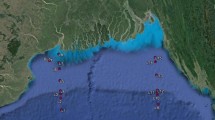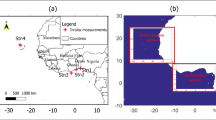Abstract
Third-generation models employ a host of parameterization schemes to consider the input wind forcing and the wave energy dissipation under different physical settings and environmental conditions. To evaluate the performance of such models in large-scale enclosed water bodies, WAVEWATCH-III model has been employed for the Caspian Sea which is a land-locked water body, located in the north of Iran. The Caspian Sea consists of three interconnected regions, called the northern, middle, and southern Caspian Sea. The division is based on the bathymetry and morphologic features, and the rapid variability in depth provides a unique modeling challenge. Recently implemented “ST6” physics in the WAVEWATCH-III model is calibrated and evaluated for the Caspian Sea. Moreover, both bottom friction methods, viz., JONSWAP and SHOWEX, in combination with calibrated ST6 were employed to fine-tune the model for this fetch-limited basin. Model performance was assessed using recent coastal measurements along the southern Caspian Sea as well as altimeter data via statistical parameters. Using ST6 calibration, the HH index for model performance against altimeter data was decreased by 7.7%. For the ADCP data, this improvement was ~17% at Noshahr station, and ~7% at Roudsar station, both along the southern boundary of the sea. The bias was decreased by 19.3% by calibrating the ST6 source term, specifically in the deeper areas. It should be noted that the bias against altimeter data has been improved by 19.5%. Due to the steep slope of the surf zone, the model was not so sensitive to the bottom friction formulation; however, the 1D propagation tests confirmed a slightly better performance of the SHOWEX formulation than that of the JONSWAP formulation.














Similar content being viewed by others
References
Amarouche K, Akpınar A, Bachari NEI, Çakmak RE, Houma F (2019) Evaluation of a high-resolution wave hindcast model SWAN for the West Mediterranean basin. Appl Ocean Res 84:225–241
Ardhuin F, O’reilly W, Herbers T, Jessen P (2003) Swell transformation across the continental shelf. Part I: Attenuation and directional broadening. J Phys Oceanogr 33:1921–1939
Ardhuin F et al (2010) Semiempirical dissipation source functions for ocean waves. Part I: Definition, calibration, and validation. J Phys Oceanogr 40:1917–1941
Babanin A (2011) Breaking and dissipation of ocean surface waves. University Press, Cambridge. https://doi.org/10.1017/CBO9780511736162
Babanin AV, Banner ML, Young IR, Donelan MA (2007) Wave-follower field measurements of the wind-input spectral function. Part III: Parameterization of the wind-input enhancement due to wave breaking. J Phys Oceanogr 37:2764–2775
Battjes JA, Janssen J (1978) Energy loss and set-up due to breaking of random waves. Coast Eng 1978:569–587
Benoit M, Marcos F, Becq F (1997) Development of a third generation shallow-water wave model with unstructured spatial meshing. Coast Eng 1996:465–478
Beyramzade M, Siadatmousavi SM, Nik MM (2019) Skill assessment of SWAN model in the red sea using different wind data Regional Studies in Marine. Science 100714
Birkemeier WA, Thornton EB (1994) The DUCK94 nearshore field experiment. In: Coastal Dynamics94. ASCE, pp 815-821
Booij N, Ris RC, Holthuijsen LH (1999) A third-generation wave model for coastal regions: 1. Model description and validation. J Geophys Res Oceans 104:7649–7666
Bouws E, Komen G (1983) On the balance between growth and dissipation in an extreme depth-limited wind-sea in the southern North Sea. J Phys Oceanogr 13:1653–1658
Donelan M, Curcic M, Chen SS, Magnusson A (2012) Modeling waves and wind stress. Jo Geophys Res Oceans 117
Firoozfar A, Neshaei MAL, Dykes AP (2014) Beach profiles and sediments, a case of Caspian Sea. Int J Marine Sci 4
French JR, Crescenti GH, Crawford TL, Dumas EJ (2000) Longez (N 3 R) participation in the 1999 shoaling waves experiment (SHOWEX) 2000
Grant WD, Madsen OS (1979) Combined wave and current interaction with a rough bottom. J Geophys Res Oceans 84:1797–1808
Hanna SR, Heinold DW (1985) Development and application of a simple method for evaluating air quality models. vol 4409. American Petroleum Institute
Hasselmann K (1973) TP Barnett, E Bouws, H Carlson, DE Cartwright, K Enke, JA Ewing, H Gienapp, DE Hasselmann, P Kruseman, A Meerburg, P Müller, DJ Olbers, K Richter, W Sell, and H Walden
Hasselmann S, Hasselmann K, Allender J, Barnett T (1985) Computations and parameterizations of the nonlinear energy transfer in a gravity-wave spectrum. Part II: Parameterizations of the nonlinear energy transfer for application in wave models. J Phys Oceanogr 15:1378–1391
Hsiao S-C, Chen H, Chen W-B, Chang C-H, Lin L-Y (2019) Quantifying the contribution of nonlinear interactions to storm tide simulations during a super typhoon event. Ocean Eng 194:106661
Janssen PA (1991) Quasi-linear theory of wind-wave generation applied to wave forecasting. J Phys Oceanogr 21:1631–1642
Komen G, Hasselmann K, Hasselmann K (1984) On the existence of a fully developed wind-sea spectrum. J Phys Oceanogr 14:1271–1285
Liu Q, Babanin A, Fan Y, Zieger S, Guan C, Moon I-J (2017) Numerical simulations of ocean surface waves under hurricane conditions: assessment of existing model performance. Ocean Model 118:73–93
Liu Q et al (2019) Observation-based source terms in the third-generation wave model WAVEWATCH III: updates and verification. J Phys Oceanogr 49:489–517
Mentaschi L, Besio G, Cassola F, Mazzino A (2013) Problems in RMSE-based wave model validations. Ocean Model 72:53–58
Parizanganeh A Grain size effect on trace metals in contaminated sediments along the Iranian coast of the Caspian Sea. In: Proceedings of Taal2007: The 12th World Lake Conference, 2008. p 336
Resio D, Perrie W (1991) A numerical study of nonlinear energy fluxes due to wave-wave interactions Part 1. Methodology and basic results. J Fluid Mech 223:603–629
Rogers E, Babanin A, Wang D (2012) Observation-consistent input and whitecapping dissipation in a model for wind-generated surface waves: description and simple calculations. J Atmos Ocean Technol 29:1329–1346. https://doi.org/10.1175/JTECH-D-11-00092.1
Sahoo B, Jose F, Bhaskaran PK (2019) Hydrodynamic response of Bahamas archipelago to storm surge and hurricane generated waves–a case study for Hurricane Joaquin. Ocean Eng 184:227–238
Seyedvalizadeh MM, Siadatmousavi SM, Ghaffari P (2020) Currents and physical parameters in deep waters of the Southern Caspian Sea accepted for publication in Iranian Journal of Oceanography (in Farsi)
Siadatmousavi SM, Jose F, da Silva GM (2016) Sensitivity of a third generation wave model to wind and boundary condition sources and model physics: a case study from the South Atlantic Ocean off Brazil coast. Comput Geosci 90:57–65
Siadatmousavi SM, Jose F, Stone G (2011a) Evaluation of two WAM white capping parameterizations using parallel unstructured SWAN with application to the Northern Gulf of Mexico, USA. Appl Ocean Res 33:23–30
Siadatmousavi SM, Jose F, Stone GW (2011b) The effects of bed friction on wave simulation: implementation of an unstructured third-generation wave model, SWAN. J Coastal Res 27(1):140–152
Siadatmousavi SM, Jose F, Stone G (2012) On the importance of high frequency tail in third generation wave models. Coast Eng 60:248–260
Tolman HL (1991) A third-generation model for wind waves on slowly varying, unsteady, and inhomogeneous depths and currents. J Phys Oceanogr 21:782–797
Tolman HL, Chalikov D (1996) Source terms in a third-generation wind wave model. J Phys Oceanogr 26:2497–2518
Tracy BA, Resio DT (1982) Theory and calculation of the nonlinear energy transfer between sea waves in deep water In Proceedings of the Army Numerical and Computers Analysis Conference, US Army Research Office:457
Wamdi G (1988) The WAM model—a third generation ocean wave prediction model. J Phys Oceanogr 18:1775–1810
Webb D (1978) Non-linear transfers between sea waves. Deep-Sea Res 25:279–298
Wiese A, Staneva J, Schulz-Stellenfleth J, Behrens A, Fenoglio-Marc L, Bidlot J-R (2018) Synergy of wind wave model simulations and satellite observations during extreme events. Ocean Sci 14:1503–1521
Zieger S, Babanin AV, Rogers WE, Young IR (2015) Observation-based source terms in the third-generation wave model WAVEWATCH. Ocean Model 96:2–25
Zijlema M, Van Vledder GP, Holthuijsen L (2012) Bottom friction and wind drag for wave models. Coast Eng 65:19–26
Acknowledgements
The authors would thank Iranian Ports & Maritime Organization for providing the in situ measurements and ifremer for providing the altimeter data.
Author information
Authors and Affiliations
Corresponding author
Additional information
Responsible Editor: Bruno Castelle
Rights and permissions
About this article
Cite this article
Alipour, A., Siadatmousavi, S.M. & Jose, F. Numerical simulation of waves in the Caspian Sea: calibration and verification of the observation-based source terms. Ocean Dynamics 71, 699–714 (2021). https://doi.org/10.1007/s10236-021-01465-w
Received:
Accepted:
Published:
Issue Date:
DOI: https://doi.org/10.1007/s10236-021-01465-w




